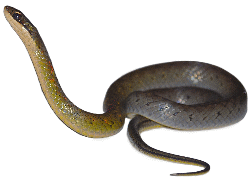  Poison dart frogs are amphibians that live in the rainforests of Central and South America, near streams or ponds. The Dendrobatidae family of frogs includes some of the world's most toxic species. The Golden Poison Dart frog, for example, contains enough poison to kill 10 adult men. The frogs' poison is found in their skin, making them toxic to the touch. The toxins can cause reactions in humans ranging from mild numbness to paralysis and death, depending on the type of toxin and the dose.
Poison dart frogs are amphibians that live in the rainforests of Central and South America, near streams or ponds. The Dendrobatidae family of frogs includes some of the world's most toxic species. The Golden Poison Dart frog, for example, contains enough poison to kill 10 adult men. The frogs' poison is found in their skin, making them toxic to the touch. The toxins can cause reactions in humans ranging from mild numbness to paralysis and death, depending on the type of toxin and the dose.While most species of these frogs are considered toxic but not deadly, they are distasteful to a predator and can sometimes be fatal. The poison can cause serious swelling, nausea, and paralysis. If a predator survives eating one, it will try not to eat anything similar in the future. In this way, an entire species of frogs of a particular colour can benefit. Depending on the species, a Poison Dart frog can be yellow, copper, gold, red, blue, green, black or a combination of these colours. Their designs help warn predators of the danger they represent, a defense mechanism known as 'aposematic colouration'.  Indigenous cultures, such as the Chocó people of Colombia, have occasionally used these frogs' poisons for centuries to coat the tip of their blow darts before hunting, a tradition that inspired the frogs' common name. However, South American people who hunt with arrows usually coat their arrow tips with plant poisons, not frog poisons, so the name is not very accurate, especially since some species in this family are not poisonous at all. Despite their fearsome traits, Poison Dart frogs are relatively small and usually grow to be just 2.5 to 5 centimetres long. Unlike many other amphibians, poison dart frogs are diurnalactive during the day
. Most species are terrestriallive on the ground
but a few are arboreallive in trees
. The frogs are insectivores, preferring to eat ants and other small insects that they can hunt among the leaf litter of the forest floor. The toxins in the frogs' bodies may be related to the type and amount of insects that they eat. Due to their toxicity, Poison Dart frogs have only one natural predator, the Leimadophis epinephelus, a species of snake that has developed a resistance to their venom.
Due to their toxicity, Poison Dart frogs have only one natural predator, the Leimadophis epinephelus, a species of snake that has developed a resistance to their venom. Far more detrimental to the species is the destruction of their habitat. Many poison dart frog species are facing a decline in numbers, and some have been classified as endangered, due to the loss of their rainforest habitat. Female Poison Dart frogs will lay over 30 eggs wrapped in a jellylike substance on the forest floor. When the eggs hatch, the tadpoles will wriggle onto the parent's back where they will be safe from predators until the parents find a small pool of water for them to continue their metamorphosischange to adult form
. Every few days, the female will return to these pools to deposit several infertile eggs which provide nutrition for the young, who will reach their full size within several months.
Each poison frog species produces a different kind of toxin made from different chemicals. Scientists have been investigating medical uses for frog poisons and have discovered that some of these may be beneficial for people with certain heart and circulatory conditions. Also, a new painkiller has been created that is 200 times more effective than morphine, without the side effects! |